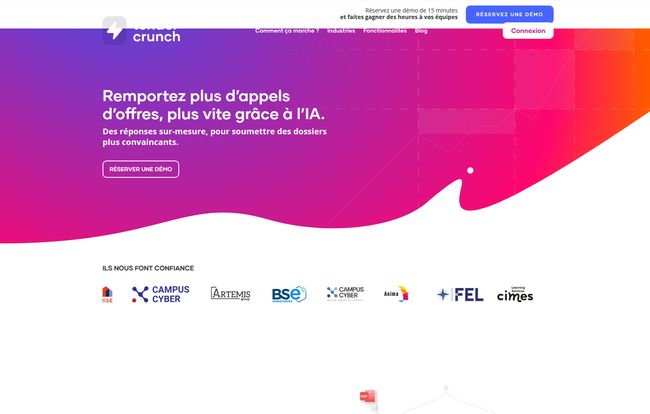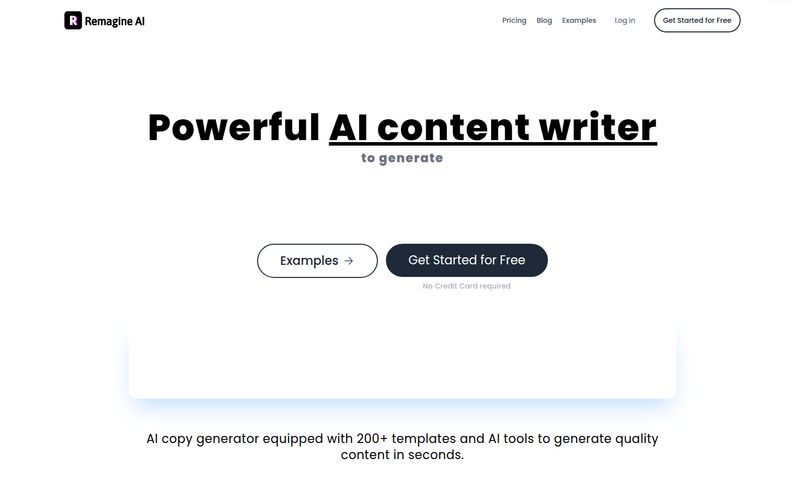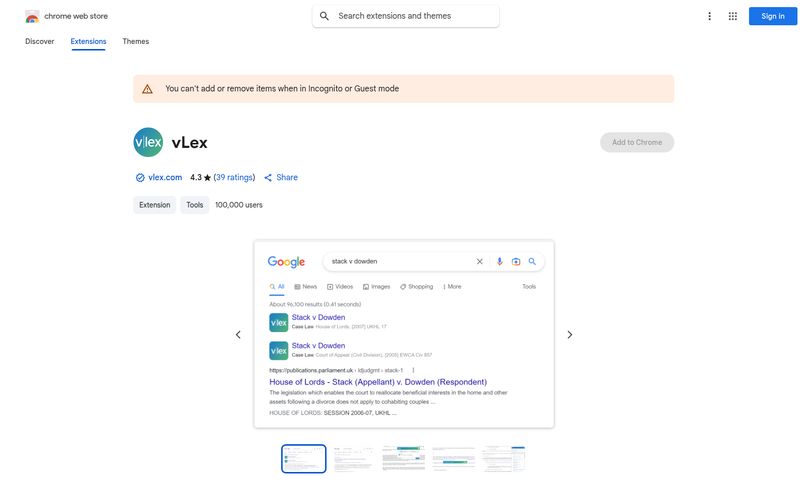Nobody gets into business because they have a burning passion for filling out Request for Proposal documents. Nobody. RFPs are the corporate equivalent of doing your taxes—necessary, often painful, and something you put off until the last possible minute. I’ve been in the trenches of business development and traffic generation for years, and I’ve seen teams burn out on RFPs, RFIs, and all the other three-letter acronyms that haunt our nightmares.
The process is almost always a frantic scavenger hunt. You're digging through old submissions, bugging subject matter experts on Slack who are already swamped, and trying to rephrase the same company boilerplate for the thousandth time. It’s a time-suck. It’s prone to errors. And frankly, it’s a massive drain on creativity and morale. So, when I hear about a tool that promises to use AI to kill this particular dragon, my ears perk up. The latest one to cross my desk is TenderCrunch, and I have to say, I'm intrigued.
What is TenderCrunch Anyway?
At its heart, TenderCrunch is an RFP response management software. But that's a bit of a dry description. Think of it more like an AI-powered co-pilot for your bid team. It’s designed to take the entire messy, chaotic process of responding to a tender and streamline it, from days of frantic work down to mere minutes. That's a bold claim. It uses AI to search your company’s collective knowledge, draft answers, and keep everything consistent and on-brand, freeing up your human experts to do what they do best: strategize and win.
A Personal Detour into RFP Hell
I remember one specific bid a few years back. It was a massive public sector contract, the kind that could make your year. The RFP document was a 150-page PDF beast, filled with legalese and oddly specific technical questions. Our team spent the better part of two weeks locked in a war room, fueled by stale coffee and rising panic. We had three different people writing the same section without realizing it, a critical piece of security compliance info was outdated, and the final submission felt… patched together. We didn't win. That experience isn't unique; it’s the default for so many companies. It’s this exact kind of chaos that tools like TenderCrunch aim to solve.
How TenderCrunch Turns RFP Chaos into Order
TenderCrunch's approach is methodical and, honestly, just makes sense. It’s not about a magic button that does everything for you (sorry to disappoint). Instead, it’s a structured, four-step workflow that builds on itself. This is how they turn that mountain of paperwork into a manageable molehill.
Building Your Team's Central Brain
First, you create your knowledge base. This is the most crucial step and, yes, it requires some front-loaded effort. You feed the system all your existing content—past winning proposals, technical documents, legal disclaimers, case studies, even your team's security certifications. This isn't just a document dump; it becomes a living, breathing, and most importantly, searchable repository of your company's expertise. It's like creating a digital librarian who has read everything your company has ever written and can recall it instantly.
Feeding the Machine
Once your knowledge base is set, you just drag and drop the new RFP, RFI, or whatever questionnaire you've received into the platform. TenderCrunch's AI gets to work immediately, parsing the document—whether it’s a PDF, Word doc, or a sprawling Excel sheet—and understanding its structure and questions. No more manually copying and pasting each question into a new document. Chef's kiss.

Visit TenderCrunch
The AI Magic Wand
This is where the fun starts. The platform analyzes each question from the new tender, dives into your knowledge base to find the most relevant information, and then generates a draft response. It’s not just pulling an old answer verbatim. The AI is smart enough to generate text with the right tone, level of detail, and formatting. The company claims it can generate a first draft of a proposal in about 5 minutes, which is just… wild.
The Human in the Loop
Finally, you review, adjust, and export. The AI gives you a massive head start—a reported 70% time savings per file—but the final polish is up to you. Your team can then focus their precious time on refining the answers, adding strategic nuance, and ensuring the proposal is not just compliant, but persuasive. This keeps the human expert in control, which is exactly where they should be.
The Standout Features I Actually Care About
Beyond the core workflow, a few things really jumped out at me. The AI Search is obviously the star. It's not just a keyword search; it understands context and semantics, which means it can find the right answer even if the question is phrased in a weird way. The Team Collaboration features are also a huge plus, allowing multiple people to work on a proposal without stepping on each other's toes or creating version control nightmares.
But for me, the biggest win is the promise of consistency. Every response that goes out the door is aligned, up-to-date, and uses the correct, approved information from your knowledge base. This eliminates human error and ensures that every proposal represents the very best of your company.
The Good, The Bad, and The Pricey
No tool is perfect, right? Here’s my honest take on the highs and lows.
What I Loved (The Big Wins)
The benefits are pretty clear. You're going to save an enormous amount of time, which directly translates to being able to respond to MORE bids. More bids, better quality bids… you can do the math on your win rate. Centralizing all that institutional knowledge is a massive asset in itself, protecting you from brain drain when a key employee leaves. And reducing the manual, repetitive grunt work? That’s a straight-up boost for team morale. Happier team, better work.
A Few Things to Keep in Mind
On the flip side, you have to go in with your eyes open. That initial setup of the knowledge base is a real task. It’s an investment, not a plug-and-play solution. Also, premium features like Single Sign-On (SSO) and dedicated support are locked behind the highest pricing tier, which is pretty standard for SaaS but something to be aware of if you're a larger organization.
So, How Much Does TenderCrunch Cost?
TenderCrunch offers a tiered pricing model that scales with your needs. While they ask you to contact them for specific numbers (a common practice for B2B SaaS), they lay out the plans quite clearly on their website.
| Plan | Best For |
|---|---|
| Basic | Perfect for small teams just starting to streamline their response workflows. |
| Standard | Ideal for businesses of any size looking to really boost collaboration and response speed. |
| Premium | Tailored for large organizations with complex needs, requiring SSO and dedicated support. |
| Custom | For those who need unique features or higher limits. You'll need to talk to their sales team. |
My advice? Start a conversation with them. A demo is probably the best way to see if the value aligns with the cost for your specific use case.
Frequently Asked Questions about TenderCrunch
- Is TenderCrunch secure for sensitive company data?
- Yes. They make a point of mentioning their security credentials. Data is hosted in France on SecNumCloud certified servers and the platform is 100% GDPR compliant. That's a serious commitment to data security.
- What kind of industries can use TenderCrunch?
- Based on their website, a whole lot of them. They list everything from IT and Digital to Public Works, Logistics, Healthcare, and Consulting. The platform seems to be industry-agnostic, focusing on the process rather than a specific sector.
- Does the AI completely replace the need for a proposal writer?
- Absolutely not. It’s a force multiplier, not a replacement. The AI handles the heavy lifting—the research and first draft—so your human team can focus on strategy, persuasion, and customization. It’s a collaboration.
- How long does it take to get started?
- The main setup task is building your knowledge base. The time this takes will depend on how organized your existing content is. It’s an initial investment of time that pays off in the long run.
- Is there a free trial available?
- The website prompts you to "Réserver une démo" (Book a Demo). This is typical for specialized B2B software. A personalized demo is often more valuable than a limited free trial, as it allows you to see how the tool would handle your specific challenges.
My Final Verdict: Is TenderCrunch a Game-Changer?
Look, the world of RFPs is changing. The old way of doing things—the frantic searching, the endless copy-pasting—is just not sustainable if you want to grow. A tool like TenderCrunch isn't just a 'nice to have'; for many businesses, it's becoming a competitive necessity.
It turns a reactive, stressful process into a proactive, strategic one. It transforms your scattered company knowledge into a powerful, centralized asset. If your team is spending more time searching for answers than crafting winning arguments, then yes, I think TenderCrunch could absolutely be a game-changer for you. It's a smart investment in efficiency, consistency, and ultimately, a higher win rate. And that's something any business can get excited about.



